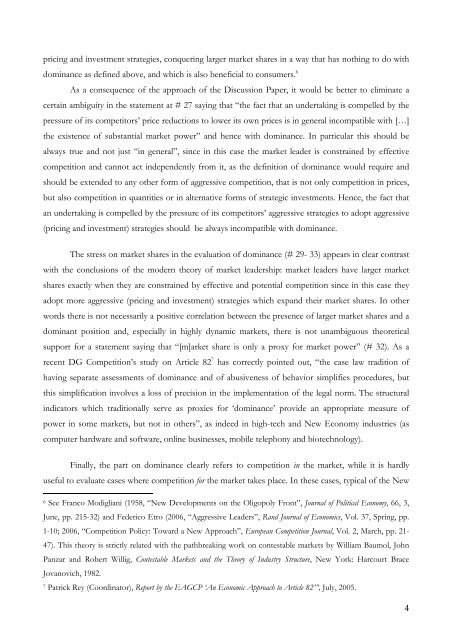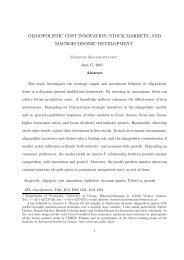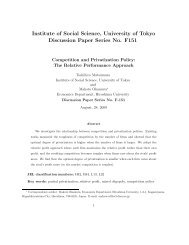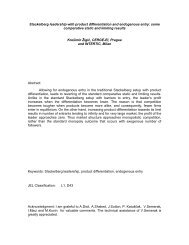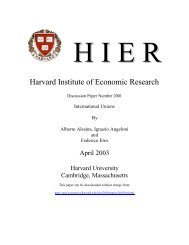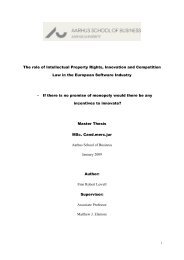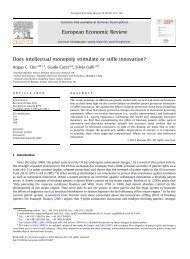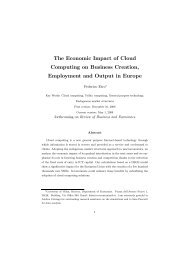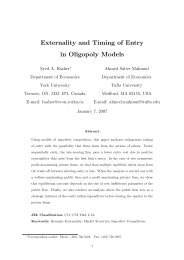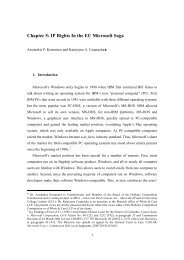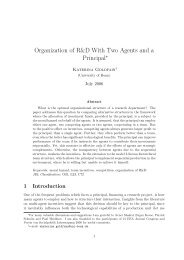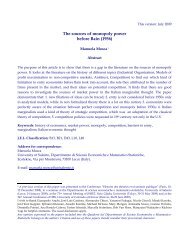The EU Approach to Abuse of Dominance - Intertic
The EU Approach to Abuse of Dominance - Intertic
The EU Approach to Abuse of Dominance - Intertic
You also want an ePaper? Increase the reach of your titles
YUMPU automatically turns print PDFs into web optimized ePapers that Google loves.
pricing and investment strategies, conquering larger market shares in a way that has nothing <strong>to</strong> do with<br />
dominance as defined above, and which is also beneficial <strong>to</strong> consumers. 6<br />
As a consequence <strong>of</strong> the approach <strong>of</strong> the Discussion Paper, it would be better <strong>to</strong> eliminate a<br />
certain ambiguity in the statement at # 27 saying that “the fact that an undertaking is compelled by the<br />
pressure <strong>of</strong> its competi<strong>to</strong>rs’ price reductions <strong>to</strong> lower its own prices is in general incompatible with […]<br />
the existence <strong>of</strong> substantial market power” and hence with dominance. In particular this should be<br />
always true and not just “in general”, since in this case the market leader is constrained by effective<br />
competition and cannot act independently from it, as the definition <strong>of</strong> dominance would require and<br />
should be extended <strong>to</strong> any other form <strong>of</strong> aggressive competition, that is not only competition in prices,<br />
but also competition in quantities or in alternative forms <strong>of</strong> strategic investments. Hence, the fact that<br />
an undertaking is compelled by the pressure <strong>of</strong> its competi<strong>to</strong>rs’ aggressive strategies <strong>to</strong> adopt aggressive<br />
(pricing and investment) strategies should be always incompatible with dominance.<br />
<strong>The</strong> stress on market shares in the evaluation <strong>of</strong> dominance (# 29- 33) appears in clear contrast<br />
with the conclusions <strong>of</strong> the modern theory <strong>of</strong> market leadership: market leaders have larger market<br />
shares exactly when they are constrained by effective and potential competition since in this case they<br />
adopt more aggressive (pricing and investment) strategies which expand their market shares. In other<br />
words there is not necessarily a positive correlation between the presence <strong>of</strong> larger market shares and a<br />
dominant position and, especially in highly dynamic markets, there is not unambiguous theoretical<br />
support for a statement saying that “[m]arket share is only a proxy for market power” (# 32). As a<br />
recent DG Competition’s study on Article 82 7 has correctly pointed out, “the case law tradition <strong>of</strong><br />
having separate assessments <strong>of</strong> dominance and <strong>of</strong> abusiveness <strong>of</strong> behavior simplifies procedures, but<br />
this simplification involves a loss <strong>of</strong> precision in the implementation <strong>of</strong> the legal norm. <strong>The</strong> structural<br />
indica<strong>to</strong>rs which traditionally serve as proxies for ‘dominance’ provide an appropriate measure <strong>of</strong><br />
power in some markets, but not in others”, as indeed in high-tech and New Economy industries (as<br />
computer hardware and s<strong>of</strong>tware, online businesses, mobile telephony and biotechnology).<br />
Finally, the part on dominance clearly refers <strong>to</strong> competition in the market, while it is hardly<br />
useful <strong>to</strong> evaluate cases where competition for the market takes place. In these cases, typical <strong>of</strong> the New<br />
6 See Franco Modigliani (1958, “New Developments on the Oligopoly Front”, Journal <strong>of</strong> Political Economy, 66, 3,<br />
June, pp. 215-32) and Federico Etro (2006, “Aggressive Leaders”, Rand Journal <strong>of</strong> Economics, Vol. 37, Spring, pp.<br />
1-10; 2006, “Competition Policy: Toward a New <strong>Approach</strong>”, European Competition Journal, Vol. 2, March, pp. 21-<br />
47). This theory is strictly related with the pathbreaking work on contestable markets by William Baumol, John<br />
Panzar and Robert Willig, Contestable Markets and the <strong>The</strong>ory <strong>of</strong> Industry Structure, New York: Harcourt Brace<br />
Jovanovich, 1982.<br />
7 Patrick Rey (Coordina<strong>to</strong>r), Report by the EAGCP ‘An Economic <strong>Approach</strong> <strong>to</strong> Article 82’”, July, 2005.<br />
4


